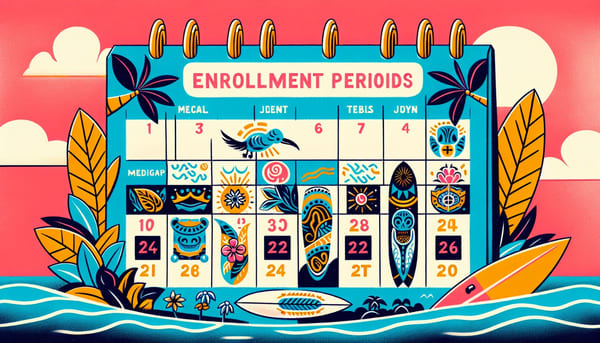
by Russell Noga | Updated April 10th, 2024
Looking for insights on Medicare Supplement Plans in Hawaii for 2025? This guide provides the essentials on the latest Medigap policies, their coverage details, and the practical steps to enroll or switch plans. No fluff, just critical insights to help Hawaiians understand their Medicare supplement options and prepare financially for the upcoming year.
Key Takeaways
- Hawaii offers ten standardized Medigap plans designed to cover out-of-pocket costs not covered by Original Medicare, with top plans for 2025 being Plan F, G, and N, featuring a range of benefits and competitive premiums.
- Medigap plans to provide extensive coverage and work alongside Original Medicare, with policies offering direct access to specialists and continuous coverage after Original Medicare benefits are exhausted, including foreign travel emergencies.
- Eligibility for Medigap plans in Hawaii requires individuals to be at least 65 years old and enrolled in Medicare Parts A and B. Enrollment periods and state-specific mandates affect availability and options for beneficiaries under 65 with disabilities.
Compare 2025 Plans & Rates
Enter Zip Code
Understanding Medicare Supplement Plans in Hawaii

Medigap plans, also known as Medicare supplement insurance, are like the trusty umbrella you carry on a cloudy day. They’re there to provide coverage when the healthcare rain starts to pour. These plans supplement Original Medicare by covering out-of-pocket costs such as copayments, coinsurance, and deductibles. In other words, they’re your financial armor against unexpected health expenses. But how do they work with Original Medicare?
For many Hawaii residents, Medigap policies offer a smoother healthcare journey. Unlike Medicare Advantage plans, which might necessitate referrals, Medigap policies provide beneficiaries with more direct access to specialized care. They’re like a VIP pass to the healthcare concert, simplifying the complexities of medical coverage.
What are Medigap plans?
Think of Medigap plans as your healthcare GPS. They fill in the gaps in Original Medicare coverage, taking care of additional out-of-pocket costs that can drain your savings. In Hawaii, these plans come in ten standardized packages, each offering a unique blend of benefits to cater to a wide array of healthcare needs.
Medigap plans offer a range of benefits, including:
- Coverage for Medicare Part A coinsurance for hospital and hospice care
- Coverage for Part B coinsurance and copayments
- Coverage for costs associated with foreign travel emergencies up to 80%
- Extended coverage for additional hospital costs up to 365 days after Medicare benefits are exhausted
These plans go the extra mile to lighten your healthcare burden and make them a reliable healthcare companion.
How Medigap plans work with Original Medicare
Medigap plans and Original Medicare are like two peas in a pod. They work hand-in-hand to ensure you receive comprehensive healthcare coverage. When you avail of healthcare services, Medicare first clears its share of covered healthcare costs. Then, like a reliable backup, Medigap steps in to pay its share.
In the Aloha State, Medigap plans go above and beyond to cover Medicare Part A coinsurance for hospital and hospice care, as well as Medicare Part B coinsurance and copayments, including preventive services. And Hawaii takes the cake by mandating insurers to offer Medigap plans on a guaranteed-issue basis to individuals under 65 who qualify for Medicare due to a disability, ensuring no one is left in the healthcare lurch.
Top Medicare Supplement Plans in Hawaii for 2025

As we look ahead to 2025, three Medigap plans shine brightly on Hawaii’s healthcare horizon – Plans F, G, and N. These plans have earned the top spots for their comprehensive coverage and competitive premiums. Each plan brings a unique blend of benefits to the table, offering a balance of coverage and cost-efficiency.
Plan F, the master of full coverage, excludes only the Part B deductible and includes 80% foreign travel exchange coverage. Plan G, on the other hand, covers everything except the Part B deductible and also includes 80% foreign travel exchange. Lastly, Plan N provides a budget-friendly alternative without covering Part B excess charges while still offering substantial coverage.
The best part? These plans are offered by trusted providers like State Farm and Cigna, ensuring you receive top-notch healthcare services without breaking the bank.
Medigap Plan G Benefits: Is This the Best Plan for You?
As we look toward 2025, Medicare Plan G is being recognized as a standout choice for beneficiaries, and its popularity is growing. With Medicare receiving enhancements overall, support for Medicare Advantage and Part D programs will also see an uptick, strengthening the appeal of Medicare Plan G as a solid choice for beneficiaries.
The advantages of Medicare Plan G are comprehensive. It includes coverage for the Part A deductible and coinsurance for hospital stays, hospice care, and skilled nursing facility care. It also addresses the Part B coinsurance and copayments, which cover doctor visits and outpatient therapy. Furthermore, Plan G provides coverage for the first three pints of blood required for a medical procedure.
A key feature of Plan G is its foreign travel emergency coverage, which pays for a significant portion of emergency care costs abroad within the plan’s limits. This is particularly beneficial for those who love to travel. In addition, Plan G also covers excess charges that may arise when a provider bills more than the Medicare-approved amount.
Whether Medicare Plan G is the best fit for you depends on your individual healthcare needs and financial considerations. Although Plan G does not cover the Part B deductible, its extensive coverage can help to minimize other out-of-pocket costs. For many, the balance of coverage and personal expenses makes Plan G an attractive option, and it could be the ideal plan for those seeking thorough coverage with less concern about the Part B deductible.
To sum up, Medicare Plan G in 2025 is poised to be a strong contender in the healthcare landscape, offering a comprehensive array of benefits that can lead to financial stability and peace of mind for many beneficiaries in Hawaii.
Medigap Plan N Benefits Compared to Plan G
As we look toward 2025, Medicare Plan N is emerging as a noteworthy contender in the suite of Medigap plans available to Hawaii residents. It’s designed for those who prefer a lower premium in exchange for taking on a small annual deductible and some copayments. Plan N covers the Part A deductible and coinsurance, including hospital and hospice care, as well as skilled nursing facility care. It also takes care of Part B coinsurance costs, typically leaving a copayment of up to $20 for some office visits and up to $50 for emergency room visits that don’t result in an inpatient admission.
A distinctive feature of Plan N is that it does not cover Part B excess charges, which are additional charges beyond what Medicare approves. However, these charges are not common, as most healthcare providers accept Medicare assignment rates.
Comparatively, Plan G is often seen as a middle ground between the comprehensive coverage of Plan F (which is no longer available to new Medicare enrollees as of January 1, 2020) and the cost-saving features of Plan N. Plan G covers all out-of-pocket expenses except for the Medicare Part B deductible. It also includes foreign travel emergency coverage, similar to Plan N, and covers Part B excess charges, which Plan N does not.
Choosing between Plan N and Plan G comes down to individual preferences and healthcare needs. If you are comfortable with a small annual deductible and possible copayments for doctor’s visits and ER trips, Plan N may offer you the cost savings you’re looking for. On the other hand, if you prefer to have nearly all out-of-pocket costs covered and don’t mind paying a higher monthly premium, Plan G might be the better option.
Medicare Plan F 2025
For those eligible, Plan F continues to serve as a robust safety net, covering costs like Medicare Part A and Part B deductibles, coinsurance, and copayments, as well as excess charges that providers may apply beyond the Medicare-approved amounts. It also provides coverage for foreign travel emergencies, ensuring peace of mind during overseas trips.
In 2025, Medicare Plan F remains a testament to the enduring value of comprehensive coverage despite its limited availability. Beneficiaries who have held onto Plan F appreciate the predictability and security it offers, making it a preferred choice for those who became eligible for Medicare before the cutoff date and who seek to mitigate their healthcare-related financial risks.
Comparing premiums and benefits
Choosing a Medigap plan is like picking a pair of shoes – you need to find the perfect fit for your needs. This involves comparing the premiums and benefits of different Medigap plans in Hawaii. It’s essential to note that while Medigap plans are standardized, the costs can vary based on personal factors and residency.
For instance, monthly premiums for Medigap Plan G can vary widely for a 65-year-old female who does not use tobacco in Hawaii. Therefore, it’s beneficial to contact insurance companies directly to get the most current and precise pricing information for Medigap plans. The key is to identify a plan that meets your healthcare needs and remains within your budgetary constraints.
Compare Medicare Plans & Rates in Your Area
Enrollment and Eligibility for Medigap Plans in Hawaii

Navigating the enrollment and eligibility process for Medigap plans in Hawaii can seem daunting. But with the right information, it doesn’t have to be. The primary eligibility criteria for enrolling in a Medigap plan in Hawaii include being at least 65 years old and enrolled in Medicare Parts A and B.
However, it’s worth noting that Hawaii does not mandate Medigap insurers to offer plans to disabled Medicare beneficiaries under the age of 65. This may limit the options available for individuals with disabilities or end-stage renal disease. But don’t lose heart – Hawaii takes steps to ensure coverage is not denied based on medical underwriting.
Key enrollment periods
Enrollment periods play a vital role in the Medigap plan process. The Medigap Open Enrollment Period in Hawaii, for instance, begins on the first day of the month when a person turns 65 and is enrolled in Medicare Part B, lasting for 6 months. It’s the perfect window to sign up without medical underwriting. Missing this initial Medigap Open Enrollment Period could mean higher policy costs and potential denial of coverage based on medical underwriting.
But even if you miss this period, Hawaii provides a lifeline in the form of Special Enrollment Periods. These are granted under certain circumstances, such as loss of employer-sponsored health coverage, which allows beneficiaries to purchase a Medigap plan outside of standard enrollment periods.
Eligibility requirements
Let’s examine the eligibility requirements for Medigap plans in Hawaii. To be eligible, residents must be at least 65 years old and enrolled in Medicare Parts A and B. However, it’s important to note that federal law does not require insurance companies to sell Medigap policies to people under 65, even if they have Medicare because of a disability or End-Stage Renal Disease (ESRD).
Although Hawaii does not mandate that Medigap insurers offer plans to disabled Medicare beneficiaries under the age of 65, this is not a complete dead-end. Beneficiaries with Medicare due to a disability or ESRD should check with the State Insurance Department to understand their rights under state law regarding Medigap policies.
Factors to Consider When Choosing a Medigap Plan in Hawaii

Choosing a Medigap plan is like putting together a jigsaw puzzle – you need to find the perfect fit for your healthcare needs. To do so, consider factors such as coverage, costs, and provider networks. It’s all about finding the right balance between the healthcare services you anticipate needing and what you can afford.
Remember, your choice of a Medigap plan should be guided by your personal criteria, such as preferred doctors or specialized services. And while it’s important to find a plan that meets your healthcare needs, it’s equally crucial to choose one that stays within your financial means.
Coverage and benefits
When considering a Medigap plan, coverage and benefits should be at the forefront of your decision-making process. Medigap plans in Hawaii offer coverage for a variety of healthcare costs, including:
- Part A coinsurance
- Hospital costs
- Part B coinsurance or copayments
- Emergency services during foreign travel
In addition to common healthcare costs, Medigap policies also cover expenses not typically covered by Original Medicare, such as health coverage for:
- Deductibles
- Copays
- Coinsurance
- Excess charges
- Potentially, other specific health needs
Weighing these benefits against your potential healthcare needs can help you choose a plan that best aligns with your personal healthcare requirements and budget.
Costs and premiums
When exploring the landscape of Medigap plans in Hawaii, it’s crucial to sift through the various premiums and associated costs, much like you would when shopping for any significant item. The premiums for Medigap plans can vary significantly, offering a spectrum from more affordable monthly options to higher-priced ones for both standard and high-deductible plans.
These variations in cost are influenced by rating methods such as community ratings, issue-age ratings, or attained-age ratings, each impacting the premium in unique ways, often related to the policyholder’s age and the timing of the policy purchase. As you assess the different Medigap policies, it’s beneficial to balance the premium costs against the potential out-of-pocket expenses you might face, particularly if you anticipate needing extensive healthcare services.
Provider networks
One of the major advantages of Medigap plans in Hawaii is the extensive and nationwide provider network they offer. As a Medigap plan holder, you can seek services from any healthcare provider nationwide that accepts Medicare, offering significant flexibility and freedom of choice.
What’s more, Medigap plans do not restrict beneficiaries to a specific provider network. This means you have the ability to see any Medicare-accepting doctor without network limitations. However, the costs associated with Medigap policies in Hawaii may be influenced by factors such as the availability of discounts, application of medical underwriting, or preference for certain healthcare providers.
Tips for Managing Out-of-Pocket Expenses with Medigap Plans
Once you have a Medigap plan, managing out-of-pocket expenses can feel like a breeze. Medigap plans can be leveraged to cover costs like Medicare deductibles and copayments, thereby minimizing out-of-pocket expenses.
Once Original Medicare coverage has been applied, Medigap plans may cover remaining expenses such as Part A deductibles, copayments, or coinsurance.
Utilizing preventive services
An ounce of prevention is worth a pound of cure, especially when it comes to healthcare. Utilizing preventive services covered by Medigap plans in Hawaii can reduce overall healthcare costs by detecting health issues early or preventing them entirely.
Moreover, adult vaccines recommended by the CDC’s Advisory Committee on Immunization Practices no longer require deductibles, coinsurance, or any other cost-sharing under Medicare Part D and Medicare Advantage plans, making them more accessible.
Budgeting for healthcare costs
Budgeting for healthcare costs is a crucial aspect of managing out-of-pocket expenses with Medigap plans. In 2022, the premiums for standard Medigap plans in Hawaii ranged from being relatively affordable to quite costly per month, and from minimal to moderate for high-deductible plans.
When preparing for long-term healthcare costs, it’s important to take into account the potential annual increase in Medigap premiums. Additionally, consider the Medicare Part B income-based premium, deductibles, and other out-of-pocket costs in your financial planning. Keep in mind, these expenses can be offset through the coverage provided by Medigap plans.
Support and Resources for Medigap Enrollees in Hawaii
Navigating the world of Medigap plans in Hawaii doesn’t have to be a solitary journey. There are plenty of support systems and resources available for Medigap enrollees in the Aloha State. From the Hawaii State Health Insurance Assistance Program (SHIP) offering free Medicare counseling to the Medicare Savings Programs aiding with Medicare premiums, help is just around the corner.
Moreover, Hawaii’s Medicaid spend-down program can help enrollees offset certain medical costs, potentially impacting their choice of Medigap plans. And if prescription drug costs are a concern, the Extra Help program assists low-income Medicare enrollees in Hawaii with these costs, which may affect their Medigap plan utilization.
Local agencies and assistance programs
When it comes to local agencies and assistance programs, Hawaii offers a plethora of resources for Medigap enrollees. Some of these resources include:
- Lanakila Multi-Purpose Senior Center
- Kapahulu Center
- Moiliili Community Center
- Waikiki Community Center
These centers offer programs and support for seniors, including those enrolled in Medigap plans.
In addition, Hawaii’s Aging and Disability Resource Centers (ADRC) offer information and services online, including access to the Long-Term Care Ombudsman program and assistance with long-term care planning and benefits. The Medicare Rights Center also offers a national helpline to provide free counseling and assistance for those with Medicare questions, including Medigap policy issues.
Online tools and resources
In today’s digital age, online tools and resources play a crucial role in helping Medigap enrollees navigate their healthcare journey.
Our FREE plan finder tool, located right on this website, can help you compare plans and providers to find the lowest cost for you. Just type your zip code into the box and compare plans today!
If you need further assistance, you can talk to one of our licensed agents at 1-888-891-0229.
Summary
Let’s take a moment to reflect on our journey through the world of Medigap plans in Hawaii. We’ve explored the basics of Medigap plans and how they work with Original Medicare. We’ve highlighted the top Medicare Supplement plans in Hawaii for 2025 and delved into popular plans such as Medicare Plan G, Plan N, and Plan F. We’ve also discussed the enrollment and eligibility for Medigap plans in Hawaii, as well as factors to consider when choosing a plan.
In conclusion, Medigap plans in Hawaii offer a reliable safety net for healthcare costs that are not covered by Original Medicare. As we look ahead to 2025, the future of these plans appears promising, with comprehensive coverage options, competitive premiums, and robust support systems. So, as you navigate your healthcare journey, remember – with a Medigap plan by your side, you’re never alone.
Compare 2025 Plans & Rates
Enter Zip Code
Frequently Asked Questions
What should I consider when choosing between different Medicare Supplement (Medigap) plans?
When selecting a Medicare Supplement (Medigap) plan, it’s important to consider several factors to ensure the plan meets your healthcare needs and budget. Think about the types of healthcare services you frequently use and the level of coverage you’re comfortable with. Compare the benefits of each plan, such as how much they cover for hospital stays, doctor visits, and procedures. Also, consider the premiums and any out-of-pocket costs like deductibles, copayments, or coinsurance. Check if the plan covers any additional benefits that are important to you, such as foreign travel emergency care. Lastly, review the plan’s rules for seeking care from specialists and whether it requires referrals. By carefully evaluating these factors, you can choose a Medigap plan that offers the right balance of coverage and cost for your individual situation.
Can I enroll in a Medigap plan if I’m new to Medicare after 2020?
If you are new to Medicare after January 1, 2020, you will not be able to enroll in Medigap Plan F, which was phased out for new enrollees on that date. However, you still have a variety of other Medigap plans to choose from, such as Plan G or Plan N, which offer comprehensive coverage and could be more cost-effective. It’s important to compare the benefits and premiums of these plans to determine which one aligns best with your healthcare needs and budget.
What are the top Medicare Supplement plans in Hawaii for 2025?
The top Medicare Supplement plans in Hawaii for 2025 are Medigap Plans F, G, and N, known for their comprehensive coverage and competitive premiums.
What are the eligibility criteria for Medigap plans in Hawaii?
To be eligible for Medigap plans in Hawaii, you need to be at least 65 years old and enrolled in Medicare Parts A and B. However, disabled Medicare beneficiaries under the age of 65 are not guaranteed access to Medigap plans in Hawaii.
How do Medigap plans work with Original Medicare?
Medigap plans work with Original Medicare by covering costs that are not fully covered by Medicare, complementing its coverage for healthcare services. After Medicare pays its approved amount, Medigap pays its share to complete the coverage.
Speak to the Professionals about Medigap Plans and Original Medicare
If you find understanding the benefits involved with Original Medicare and Medigap Plans challenging, you’re not alone. Whether it’s a Medigap plan, or you want to know more about the Medicare Supplement Plans Hawaii in 2025, we can help. Call our team at 1-888-891-0229 for a free consultation or complete the contact form on this site, and an expert will call you back at a convenient time.
We have decades of experience advising our clients on the complexities of Medicare and Medigap plans, the benefits, cost and deductibles. We’ll ensure you get the best rate in your state and advice you can trust.

Russell Noga is the CEO and Medicare editor of Medisupps.com. His 15 years of experience in the Medicare insurance market includes being a licensed Medicare insurance broker in all 50 states. He is frequently featured as a featured as a keynote Medicare event speaker, has authored hundreds of Medicare content pages, and hosts the very popular Medisupps.com Medicare Youtube channel. His expertise includes Medicare, Medigap insurance, Medicare Advantage plans, and Medicare Part D.


